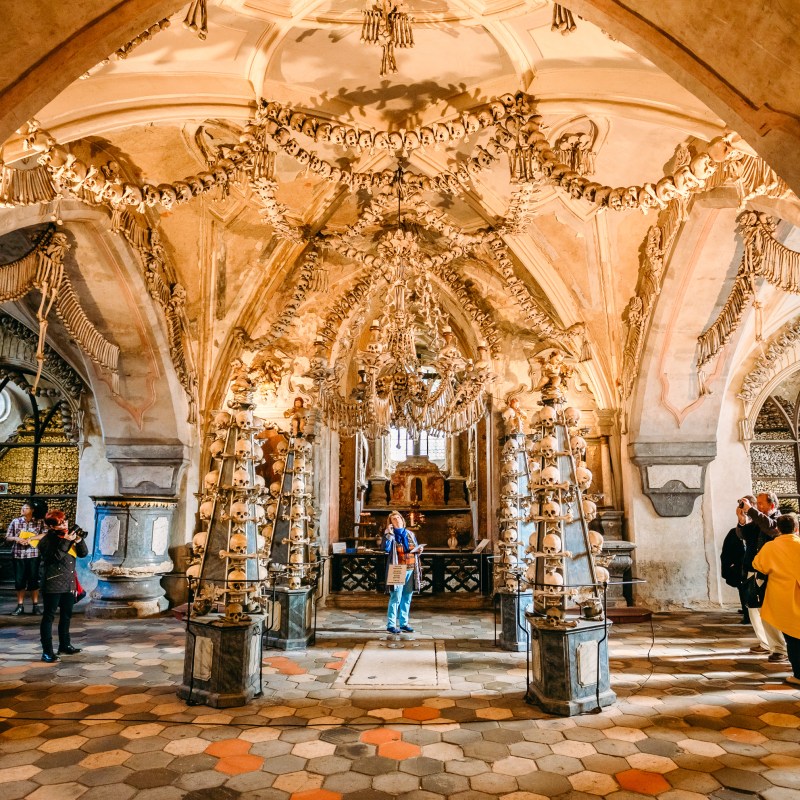
If you have a fascination with the macabre, death in any form, or just unique and weird places of worship, the Sedlec Ossuary is your ticket. The cathedral in the heart of Bohemia, in the town of Kutna Hora, Czech Republic, has been around since medieval times.
Videos by TravelAwaits
On the outside, the chapel is ordinary looking — for an ancient church, at least. When you step inside, you’ll feel the same. It’s a pretty, gothic church that the average tourist might stumble upon wandering through the suburb.
But after you pay your $5.35 entry fee, you can explore the cathedral — where Catholic mass is still held — or wander down a small staircase.

Welcome To The Church Of Bones
As you enter the chapel, you’ll see what you could expect an ossuary to hold — more than 40,000 human skeletons. But you probably wouldn’t expect them to be arranged as they are in this room.
In 1278, the King of Bohemia commissioned the Abbot of Sedlec, a Cistercian monk, to journey to Jerusalem. When the monk returned, he carried a jar of soil from the Holy Land with him. Specifically, the soil was from the location known as Golgotha — the place of the skull, where Jesus Christ was crucified — which attracted locals from Sedlec and surrounding areas to the idea of being buried in the location where the abbot sprinkled the holy soil.

During the 15th century, the gothic church was constructed with an upper chapel and lower chapel, designed to serve as the ossuary for the mass graves exhumed during its construction. The bones were stacked in the ossuary where they remained unattended for centuries.
Finally, in 1870, a local artisan — a woodcarver named Frantisek Rint — was appointed to place the bones in a decent order that would call to heart and mind religious ceremony and reverence. Piles of skulls were fashioned into a chandelier and archways. The femurs and other long bones from thousands of skeletons were formed into religious and monarchical symbols.

Beyond the chandelier, which makes use of nearly every bone in the human body, the ossuary displays four baroque bone candelabras, six giant bone pyramids, two large bone chalices, two bone monstrances — vessels used to display the Eucharist host — and skull candle holders. Chains of bone also drape their way across the ceiling and between pillars throughout the chapel.
Mass is held within the bone chapel as well, and many consider the moments in this unique setting peaceful and inspiring rather than dark or macabre.
Rint signed his work in the ossuary with a collection of bones, depicting his name and the year he finished the work.

You can visit the cathedral and ossuary any time of year. Sunday hours are 9 a.m. to 6 p.m. year-round, but note that hours on other days of the week vary by season:
- November through February, 9 a.m. to 5 p.m.
- March, 9 a.m. to 5 p.m.
- April through September, 9 a.m. to 6 p.m.
- October, 9 a.m. to 5 p.m.
The Ossuary is open every day except Christmas Eve.

The cathedral and ossuary are located in Sedlec, a suburb of Kutna Hora, which is just one hour away from Prague in the Czech Republic. Trains run hourly from Prague to Kutna Hora, costing between $3 and $6 on average. A 14- to 20-minute walk will take you from the train station to the ossuary and cathedral. You can also journey to Sedlec from Prague via bus, cab, Uber, or rental car. Technically, there’s a bus as well, but most people prefer the train or private car options as they cut down on transit time. All routes — save the bus, which takes an hour and 40 minutes or more — take approximately one hour.
Headed to the Czech Republic? Don’t miss Prague’s hidden gems or these nine weird things to do in the city.
